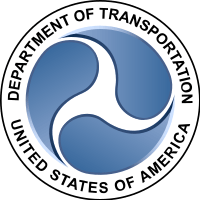National Highway Traffic Safety Administration
The National Highway Traffic Safety Administration (NHTSA, pronounced "NITZ-ah")[7] is an agency of the U.S. federal government, part of the Department of Transportation. It describes its mission as "Save lives, prevent injuries, reduce vehicle-related crashes."[8]
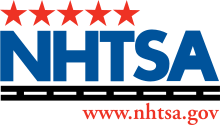 National Highway Traffic Safety Administration logo | |
| Agency overview | |
|---|---|
| Formed | December 31, 1970 |
| Preceding agency |
|
| Jurisdiction | U.S. motor vehicles[2] |
| Headquarters | Washington, D.C., U.S. |
| Motto | "People saving people"[3] |
| Employees | 626 (FY 2017)[4][5] |
| Annual budget | $899 million (FY 2017)[4] |
| Agency executives | |
| Parent department | Department of Transportation |
| Website | nhtsa |
As part of its activities, NHTSA is charged with writing and enforcing Federal Motor Vehicle Safety Standards as well as regulations for motor vehicle theft resistance and fuel economy, as part of the Corporate Average Fuel Economy (CAFE) system. FMVSS 209 was the first standard to become effective on 1 March 1967. NHTSA also licenses vehicle manufacturers and importers, allows or blocks the import of vehicles and safety-regulated vehicle parts, administers the vehicle identification number (VIN) system, develops the anthropomorphic dummies used in U.S. safety testing as well as the test protocols themselves, and provides vehicle insurance cost information. The agency has asserted preemptive regulatory authority over greenhouse gas emissions, but this has been disputed by such state regulatory agencies as the California Air Resources Board.
The Federal Motor Vehicle Safety Standards are contained in the United States Code of Federal Regulations, Title 49, Part 571. This is commonly referred to as 49CFR571, with any particular FMVSS appended after a period; for example 49CFR571.301 is the location of FMVSS 301. Additional federal vehicle standards are contained elsewhere in the CFR. For instance, 49CFR564 contained the specifications and requirements for various types of replaceable headlamp light sources (bulbs), until this information was moved to a docket elsewhere, with effect from 2 December 2012.[9]
Another of NHTSA's major activities is the creation and maintenance of the data files maintained by the National Center for Statistics and Analysis. In particular, the Fatality Analysis Reporting System (FARS), has become a resource for traffic safety research not only in the United States, but throughout the world. Research contributions using FARS by researchers from many countries appear in many non-U.S. technical publications,[10] and provide a significant database and knowledge bank on the subject. Even with this database, conclusive analysis of crash causes often remains difficult and controversial, with experts debating the veracity and statistical validity of results.[10]
History
In 1964 and 1966, public pressure grew in the United States to increase the safety of cars, culminating with the publishing of Unsafe at Any Speed, by Ralph Nader, an activist lawyer, and "Accidental Death and Disability: The Neglected Disease of Modern Society" by the National Academy of Sciences.
In 1966, Congress held a series of publicized hearings regarding highway safety, passed legislation to make installation of seat belts mandatory, and enacted Pub.L. 89–563, Pub.L. 89–564, and Pub.L. 89–670 which created the U.S. Department of Transportation on October 15, 1966. This legislation created several predecessor agencies which would eventually become NHTSA, including the National Traffic Safety Agency, the National Highway Safety Agency, and the National Highway Safety Bureau. Once the Federal Motor Vehicle Safety Standards (FMVSS) came into effect, vehicles not certified by the maker or importer as compliant with US safety standards were no longer legal to import into the United States.
Congress established NHTSA in 1970 with the Highway Safety Act of 1970 (Title II of Pub.L. 91–605, 84 Stat. 1713, enacted December 31, 1970, at 84 Stat. 1739). In 1972, the Motor Vehicle Information and Cost Savings Act (Pub.L. 92–513, 86 Stat. 947, enacted October 20, 1972) expanded NHTSA's scope to include consumer information programs. Since then, automobiles have become far better at protecting their occupants in vehicle impacts. The number of deaths on American highways hovers around 33,000 annually,[11] a lower death rate per vehicle-mile traveled than in the 1960s.
NHTSA has conducted numerous high-profile investigations of automotive safety issues, including the Audi 5000/60 Minutes affair, the Ford Explorer rollover problem and the Toyota: Sticky accelerator pedal problem. The agency has introduced a proposal to mandate Electronic Stability Control on all passenger vehicles by the 2012 model year. This technology was first brought to public attention in 1997, with the Swedish moose test. Other than that, NHTSA has issued few regulations in the past 25 years. Most of the reduction in vehicle fatality rates during the last third of the 20th century were gained from the initial NHTSA safety standards during 1968–1984 and subsequent voluntary changes in vehicle crashworthiness by vehicle manufacturers.[12]
International counterparts and the grey market
In 1958, under the auspices of the United Nations, a consortium called the Economic Commission for Europe had been established to normalize vehicle regulations across Europe so as to standardize best practices in vehicle design and equipment and minimize technical barriers to pan-European vehicle trade and traffic. This eventually became the World Forum for Harmonization of Vehicle Regulations, which began to promulgate what would eventually become the UN Regulations on the design, construction, and safety and emissions performance of vehicles and their components. Many of the world's countries accept or require vehicles and equipment built to the UN Regulations,[13] but the U.S does not recognize the UN Regulations, and blocks the importation of vehicles and components not manufacturer-certified as complying with the U.S. regulations.[14]
Because of the unavailability in America of certain vehicle models, a grey market arose in the late 1970s. This provided a method to acquire vehicles not officially offered in the United States, but enough vehicles imported this way were faulty, shoddy, and unsafe[15][16][17] that Mercedes-Benz of North America helped launch a successful congressional lobbying effort to close down the grey market in 1988.[18] As a result, it is no longer possible to import foreign vehicles into the United States as a personal import, with few exceptions—primarily vehicles meeting Canadian regulations substantially similar to those of the United States, and vehicles imported temporarily for display or research purposes. In practice the gray market involved a few thousand cars annually, before its virtual elimination in 1988.[19]
In 1998, NHTSA exempted vehicles older than 25 years from the rules it administers, since these are presumed to be collector vehicles.[14] In 1999, certain very low production volume specialist vehicles were also exempt for "Show and Display" purposes.
In the mid-1960s when the framework was established for US vehicle safety regulations, the US auto market was an oligopoly, with just three companies (GM, Ford, and Chrysler) controlling 85% of the market.[20] The ongoing ban on newer vehicles considered safe in countries with lower vehicle-related death rates has created a perception that an effect of NHTSA's regulatory activity is to protect the U.S. market for a modified oligopoly consisting of the three U.S.-based automakers and the American operations of foreign-brand producers. It has been suggested[21] that the impetus for NHTSA's seeming preoccupation with market control rather than vehicular safety performance is a result of overt market protections such as tariffs and local-content laws having become politically unpopular due to the increasing popularity of free trade, thus driving industry to adopt less visible forms of trade restrictions in the form of technical regulations different from those outside the United States.[22]
An example of the market-control effects of NHTSA's regulatory protocol is found in the agency's 1974 banning of the Citroën SM automobile, which contemporary journalists hailed as one of the safest vehicles available at the time. NHTSA disapproved the SM due to its steerable headlamps which were not of the sealed beam design mandatory in the U.S., and its height adjustable suspension, which made compliance with the 1973 bumper requirements impossible; the bumper regulation was intended to control the costs resulting from low speed collisions, not enhance occupant safety.[23]
Vehicle manufacturers have acknowledged the functional equivalence of the UN and U.S. regulations, encouraged developing countries to recognize and accept both,[13] and advocated for equal recognition of both systems even in developed countries.[24] However, some structural features of the U.S. legal system are incompatible with some aspects of the UN regulatory system.[25]
Regulatory performance
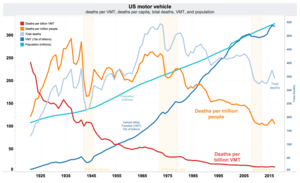
Government data (from FARS for the U.S.) in a 2004 book by former General Motors safety researcher Leonard Evans[26] shows other countries having achieved greater safety improvements over time than those achieved in the United States:
| Country | 1979 Fatalities | 2002 Fatalities | Percent Change |
|---|---|---|---|
| United States | 51,093 | 42,815 | −16.2% |
| Great Britain | 6,352 | 3,431 | −46.0% |
| Canada | 5,863 | 2,936 | −49.9% |
| Australia | 3,508 | 1,715 | −51.1% |
Research suggests one reason the U.S. continues to lag in traffic safety is the relatively high prevalence in the U.S. of pickup trucks and SUVs, which a 2003 study by the U.S. Transportation Research Board found are significantly less safe than passenger cars.[27] Comparisons of past data with the present in the U.S. can result in distortions, due to a significant population increase and since the level of large commercial truck traffic has substantially increased from the 1960s but highway capacity has not kept up.[28][29] However, other factors exert significant influence; Canada has lower roadway death and injury rates despite a vehicle mix comparable to that of the U.S.[26] Nevertheless, the widespread use of truck-based vehicles as passenger carriers is correlated with roadway deaths and injuries not only directly by dint of vehicular safety performance per se, but also indirectly through the relatively low fuel costs that facilitate the use of such vehicles in North America. Motor vehicle fatalities decline as gasoline prices increase.[30]
Development of Standardized Field Sobriety Testing (SFST) for drunk driving
NHTSA created a Standardized Field Sobriety Testing (SFST) training curriculum to prepare police officers and other qualified persons to conduct the SFST's for use in DWI investigations. This training was developed in combination with the International Association of Chiefs of Police (IACP), and has experienced remarkable success since its inception in the early 1980s.
Data-Driven Approaches to Crime and Traffic Safety (DDACTS)
NHTSA, along with the Bureau of Justice Assistance and the National Institute of Justice (both part of the Department of Justice) has a long history of actively promoting the use of traffic stops by local police to combat crime and search for drugs.[31][32] This approach is controversial and has, in the past, been accused of encouraging racial profiling of motorists.[33]
Cost and cost-benefit
It is very expensive to certify a vehicle; on a particular 2013-model vehicle, certification costs one company US$ 42 million for E.U. certification. Studies of the cost of complying with safety standards have concluded that normalizing regulations between the EU and US would significantly save budget.[34]
NHTSA uses cost–benefit analysis for every safety device, system, or design feature mandated for installation on vehicles.[35] No device, system, or design feature may not be mandated unless it will save more money (in property damage, health care, etc.) than it costs, or must cost no more than a specified amount of money per life saved. Requirements are balanced through estimated costs and estimated benefits to justify or reject regulation. For example, FMVSS #208 effectively mandates the installation of frontal airbags in all new vehicles in the United States, for it is written such that no other technology can meet the stipulated requirements.[36] It has been argued that even using conservative cost figures and optimistic benefit figures, airbags' cost–benefit ratio so extreme that it may fall outside of the cost–benefit requirements for mandatory safety devices.[37][38] Cost–benefit requirements have been used as the basis for lighting-related regulation in the U.S; for example, while many countries in the world since at least the early 1970s have required rear turn signals to emit amber light so they might be distinguished from adjacent red brake lamps, U.S. regulations permit rear turn signals to emit either amber or red light. This has historically been justified on grounds of lower manufacturing cost[39] and greater automaker styling freedom in context of no demonstrated safety benefit to amber over red.[40][41][42] More recent NHTSA-sponsored research has demonstrated that amber rear turn signals provide significantly better crash avoidance than red ones,[43][44] and NHTSA has found there is no significant cost penalty to amber signals versus red ones,[39] yet the agency has not moved to require amber—instead proposing in 2015 to award extra NCAP points to passenger vehicles with amber rear turn signals.[39] As of July 2019, the agency has not put this proposal into effect.
Fuel economy
CAFE Regulations
NHTSA also administers the Corporate Average Fuel Economy (CAFE), which is intended to incentivize the production of fuel-efficient vehicles by dint of fuel economy requirements measured against the sales-weighted harmonic average of each manufacturer's range of vehicles. Many governments outside North America regulate fuel economy by heavily taxing motor fuel and/or by including a vehicle's engine size or fuel economy in calculating vehicle registration taxes (road tax). It is argued that such regulations are not politically feasible, and that doing so would hurt the U.S. auto industry.[45][46][47] Another putative problem with CAFE is that fuel economy is negatively correlated to vehicle weight—lighter vehicles giving better fuel economy—while vehicle weight is positively correlated to safety—larger and heavier vehicles better protect their occupants.[48] Thus, NHTSA must accomplish two potentially contradictory regulatory goals at the same time. However, Transportation Research Board studies show safety disparities may exist among vehicles of differing price, country of origin, and quality not just among vehicles of different size and weight alone.[49] Some other researchers dispute the incompatibility of reduction in vehicle weight and increased fuel economy.[50]
Performance
NHTSA's Summary of Fuel Economy Performance lists manufacturer's Model Year 2014 CAFE:[51]
| Domestic Car | Imported Car | Light Truck | |||||||
|---|---|---|---|---|---|---|---|---|---|
| Manufacturer | STD | CAFE | CAFE-STD | STD | CAFE | CAFE-STD | STD | CAFE | CAFE-STD |
| BMW | 33.6 | 35.0 | 1.4 | 27.7 | 28.7 | 1 | |||
| Daimler | 33.7 | 31.4 | -2.3 | 27.3 | 24.5 | -2.8 | |||
| Fiat Chrysler* | 32.9 | 31.1 | -1.8 | 33.8 | 28.0 | -5.8 | 26.5 | 26.0 | -0.5 |
| Ford | 34.0 | 36.6 | 2.6 | 34.8 | 30.9 | -3.9 | 25.2 | 24.8 | -0.4 |
| GM | 33.9 | 34.4 | 0.5 | 37.1 | 40.9 | 3.8 | 24.4 | 25.1 | 0.7 |
| Honda | 33.8 | 39.2 | 5.4 | 34.2 | 42.0 | 7.8 | 27.5 | 29.6 | 2.1 |
| Hyundai | 34.4 | 37.3 | 2.9 | 28.7 | 27.5 | -1.2 | |||
| Jaguar Land Rover | 32.3 | 27.0 | -5.3 | 27.1 | 24.8 | -2.3 | |||
| Kia | 34.4 | 32.1 | -2.3 | 27.8 | 26.9 | -0.9 | |||
| Lotus | 36.0 | 26.7 | -9.3 | ||||||
| Mazda | 34.5 | 42.3 | 7.8 | 31.4 | 28.8 | -2.6 | |||
| Mitsubishi | 36.3 | 39.8 | 3.5 | 30.1 | 34.4 | 4.3 | |||
| Nissan | 34.7 | 41.9 | 7.2 | 34.2 | 33.1 | -1.1 | 27.3 | 27.7 | 0.4 |
| Subaru | 35.5 | 37.0 | 1.5 | 29.8 | 34.5 | 4.7 | |||
| Tesla | 32.1 | 276.7 | 244.6 | ||||||
| Toyota | 34.4 | 39.1 | 4.7 | 34.9 | 42.9 | 8 | 26.7 | 25.8 | -0.9 |
| Volvo | 33.6 | 30.5 | -3.1 | 28.2 | 26.1 | -2.1 | |||
| VW* | 33.6 | 37.7 | 4.1 | 34.9 | 34.1 | -0.8 | 27.9 | 28.6 | 0.7 |
* Subject to revision due to alleged diesel engines emissions violations.
Aerodynamics brings change to NHTSA
Automakers faced an inherent conflict between NHTSA's stringent headlight legislation, which mandated unaerodynamic sealed-beam headlights, and the Corporate Average Fuel Economy standard, which effectively mandated that automakers develop ways to improve the ability of the car to cleave the air. As a result, in the early 1980s, automakers lobbied for a modification of the mandate for fixed shape sealed-beam headlamps.
NHTSA adopted Ford's proposal for low-cost aerodynamic headlamps with polycarbonate lenses and transverse-filament bulbs. The minimum allowed performance and materials durability requirements of this new headlamp system are lower than those of the previous sealed beam system.
For the 1984 model year, Ford introduced the Lincoln Mark VII, the first car since 1939 to be sold in the U.S. market with architectural headlamps as part of its aerodynamic design. These composite headlamps, when new to the American market, were commonly but improperly referred to as "Euro" headlamps, since aerodynamic headlamps were already common in Europe. Though conceptually similar to European headlamps with nonstandardized shape and replaceable-bulb construction, these headlamps conform to the SAE headlamp design standards contained in U.S. Federal Motor Vehicle Safety Standard 108, and not to the international safety standards used worldwide outside North America.
NCAP
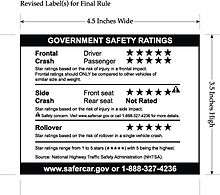
In 1979, NHTSA created the New Car Assessment Program (NCAP) in response to Title II of the Motor Vehicle Information and Cost Savings Act of 1972, to encourage manufacturers to build safer vehicles and consumers to buy them. Since that time, the agency has improved the program by adding rating programs, facilitating access to test results, and revising the format of the information to make it easier for consumers to understand.[52] NHTSA asserts the program has influenced manufacturers to build vehicles that consistently achieve high ratings.[52]
The first standardized 35 mph front crash test was May 21, 1979, and the first results were released October 15 that year.
The agency established a frontal impact test protocol based on Federal Motor Vehicle Safety Standard 208 ("Occupant Crash Protection"), except that the frontal 4 NCAP test is conducted at 35 mph (56 km/h), rather than 30 mph (48 km/h) as required by FMVSS No. 208.
More recently, in an effort to improve the dissemination of NCAP ratings and as a result of the Safe, Accountable, Flexible, Efficient Transportation Equity Act: A Legacy for Users (SAFETEA–LU) the agency has issued a Final Rule requiring manufacturers to place NCAP star ratings on the Monroney sticker (automobile price sticker). The rule has a September 1, 2007 compliance date.[53]
Administration
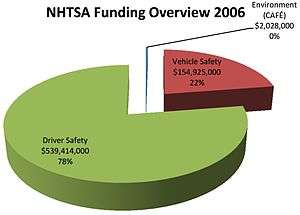
The agency has an annual budget of $1.09 billion (FY2020). The agency classifies most of its spending under the driver safety heading, with a minority spent on vehicle safety, and a smaller amount on environmental matters of which it is in charge, i.e., vehicular fuel economy.
See also
- Automobile safety rating
- Crash test
- Euro NCAP
- Grey-market vehicle
- Insurance Institute for Highway Safety
- Intelligent Transportation Systems Institute
- National Transportation Safety Board
- Road-traffic safety
- Title 23 of the Code of Federal Regulations
- UNECE
- Vehicle inspection
- Vehicular violence in the United States
- Work-related road safety in the United States
References
- "Who We Are and What We Do". National Highway Traffic Safety Administration. Archived from the original on October 18, 2015. Retrieved November 1, 2015.
- "National Highway Traffic Safety Administration". International Trade Data System. Archived from the original on September 23, 2015. Retrieved November 1, 2015.
- "THIS IS NHTSA" (PDF). National Highway Traffic Safety Administration. Retrieved November 1, 2015.
- "Budget Estimates, Fiscal Year 2018". National Highway Traffic Safety Administration. United States Department of Transportation.
- "Budget Estimates Fiscal Year 2016 National Highway Traffic Safety Administration" (PDF). U.S. Department of Transportation. Retrieved November 1, 2015.
- amy.lee.ctr@dot.gov (7 November 2019). "NHTSA Leadership". NHTSA.
- Calmes, Jackie (5 April 2014). "Minding the Minders of G.M." – via NYTimes.com.
- "Home | National Highway Traffic Safety Administration (NHTSA) | U.S. Department of Transportation". Nhtsa.dot.gov. Retrieved 2011-11-13.
- Part 564: Replaceable Light Source Information
- Wochinger, Kathryn; Compton, Richard; Berning, Amy (2015). Results of the 2013–2014 National Roadside Survey of Alcohol and Drug Use by Drivers (US Traffic Safety Facts Research Note, Report No. DOT HS No 812 118). National Highway Traffic Safety Administration. p. 575. Retrieved 5 December 2018.
- "NHTSA Budget Highlights FY2015" (PDF). NHTSA. 2014. Cite journal requires
|journal=(help) - L. S. Robertson (2007). Injury Epidemiology (Third ed.). Oxford University Press. pp. 186–194. ISBN 978-0-19-506956-3.
- Automotive Regulations and Certification Processes: Global Manufacturers' Perspective
- "What you need to know to avoid seeing your grey market car get crushed". Digital Trends. 30 August 2013. Retrieved 30 May 2015.
- U.S. Accuses 'Gray Market' Car Importer
- Deception on Engines Charged: 'Gray Market' Mercedes Dealer Held
- Wheeling-Dealing Gray Market Hits the Skids : Bad Publicity, Corporate Action, Legislation Put Brakes on Car Conversions
- "How To: Win the Car-Importing Game". Archived from the original on 3 February 2015. Retrieved 30 May 2015.
- "Car Show Classic: 1985 Citroen CX 25 GTi Series 2 – Blue Is A Warmer Color Than Grey". Curbside Classic. Retrieved 30 May 2015.
- "Carpe Diem". Retrieved 30 May 2015.
- M. E. Wenners; J. M. Frusti; J. S. Ninomiya (1998). "Global Regulatory Harmonization—One American Manufacturer's Perspective". Ref # 982266. Society of Automotive Engineers. Cite journal requires
|journal=(help) - Crouching Tariff, Hidden Trade Barrier? - DrivingVisionNews
- "Top 5: Citroen SM innovations that saw the future video - CNET". CNET. CBS Interactive. Retrieved 30 May 2015.
- Ford Push for Global Regs…Meaning What? - DrivingVisionNews
- Legal Hurdles to Regulatory Harmony - DrivingVisionNews
- Evans, Leonard (2004). Traffic Safety. Science Serving Society. ISBN 978-0-9754871-0-5.
- Wenzel, T.; Ross, M. (2003). "Are SUVs Safer than Cars? An Analysis of Risk by Vehicle Type and Model" (PDF). Transportation Research Board. Archived from the original (PDF) on 2013-05-03. Retrieved 2008-03-09. Cite journal requires
|journal=(help) - Federal Highway Administration (2006). "Chapter 14 Freight Transportation". United States Department of Transportation.
- L.S. Robertson (2006). "Motor Vehicle Deaths: Failed Policy Analysis and Neglected Policy". Journal of Public Health Policy. 27 (2): 182–189. doi:10.1057/palgrave.jphp.3200074. PMID 16961196.
- D.C. Grabowski; M.A. Morrissey (2004). "Gasoline Prices and Motor Vehicle Fatalities". Journal of Policy Analysis and Management. 23 (3): 575–593. doi:10.1002/pam.20028.
- "Data-Driven Approaches to Crime and Traffic Safety (DDACTS) - National Highway Traffic Safety Administration (NHTSA)". one.nhtsa.gov.
- "Data-Driven Approaches to Crime and Traffic Safety". National Institute of Justice.
- Kocieniewski, David (29 November 2000). "New Jersey Argues That the U.S. Wrote the Book on Race Profiling" – via NYTimes.com.
- Beene, Ryan (July 25, 2015). "Wiping out U.S.-EU rules disparities would yield big savings". Automotive News. Retrieved December 4, 2018.
- Viscusi, Kip Regulatory Economics in the Courts: an Analysis of Judge Scalia's NHTSA Bumper Decision Law and Contemporary Problems volume 50 issue 4 1988 Retrieved July 29, 2015
- 49CFR571.208
- "John Graham Releases Results of Cost–Benefit Analysis of Air Bag Safety". Riskworld.com. 1997-03-25. Archived from the original on 2011-09-28. Retrieved 2011-11-13.
- Thompson, Kimberly M.; Segui-Gomez, Maria; Graham, John D. (2002-10-03). "Risk Analysis, Volume 22 Issue 4 Page 803-811, August 2002". Risk Analysis. 22 (4): 803–811. doi:10.1111/0272-4332.00070.
- New Car Assessment Program Request For Comment, US Government Docket NHTSA-2015-0119, section D(2)(c)
- Automotive Lighting in North America, Driving Vision News, 2011
-
Hitzemeyer, E.G.; Wilde, H.; Ellenburger, D (1977). "What Color Should Rear Turn Signals Be?" (paper). Society of Automotive Engineers. Cite journal requires
|journal=(help) - D'orleans, G. (1997). "World Harmonization and Procedures for Lighting and Signaling Products" (paper). Society of Automotive Engineers. Archived from the original on 2009-02-13. Retrieved 2011-10-16. Cite journal requires
|journal=(help) - "The Influence of Rear Turn Signal Characteristics on Crash Risk" (PDF). Archived from the original (PDF) on 2009-05-11. Retrieved 2011-10-17. (527 KB)
- Allen, Kirk (2009). "The Effectiveness of Amber Rear Turn Signals for Reducing Rear Impacts, DOT HS 811 115" (PDF). National Highway Traffic Safety Administration. Cite journal requires
|journal=(help) - Knollenberg, Joe. "Big3Defense.com". Archived from the original (Website) on October 23, 2007. Retrieved October 4, 2007.
- Benton, Joe. "GM Exec Slams Higher Mileage Standards". Consumer Affairs. Archived from the original (Website) on November 28, 2007. Retrieved October 4, 2007.
- "Automakers cool to Bush plans to cut gas consumption" (Website). Channel NewsAsia. 24 January 2007. Retrieved October 4, 2007.
- Kahane, Charles (October 2003). "Vehicle Weight, Fatality Risk and Crash Compatibility of Model Year 1991–99 Passenger Cars and Light Trucks" (PDF). National Highway Traffic Safety Administration. Retrieved 2007-11-15.
- Wenzel, Tom; Ross, Marc (2003-01-15). "Are SUVs Safer than Cars? An Analysis of Risk by Vehicle Type and Model" (PDF). Transportation Research Board: 17–21. Archived from the original (PDF) on 2013-05-03. Retrieved 2007-10-04. Cite journal requires
|journal=(help) - Robertson, Leon S. (2006). "Blood and Oil: Vehicle Characteristics in Relation to Fatality Risk and Fuel Economy". American Journal of Public Health. 96 (11): 1906–1909. doi:10.2105/AJPH.2005.084061. PMC 1751827. PMID 17018814.
- CAFE December 2014. National Highway Traffic Safety Administration, U.S. Department of Transportation. Accessed October 2015.
- "The New Car Assessment Program Suggested Approaches for Future Program Enhancements" (PDF). National Highway Traffic Safety Administration. January 2007. Retrieved 2008-11-24.
- U.S. NCAP enhancements for 2007 Archived September 25, 2007, at the Wayback Machine
- NHTSA. "NHTSA Budget Overview FY 2006" (PDF). p. 4. Retrieved 2007-06-19.
Further reading
- Kevin M. McDonald, "Shifting Out of Park: Moving Auto Safety from Recalls to Reason" (Lawyers & Judges Publishing, 2006).
- Evans, Leonard (2004). Traffic Safety. Science Serving Society. ISBN 978-0-9754871-0-5.
- Code of Federal Regulations, Title 49, Transportation. Office of the Federal Register National Archives and Records Administration. 2004. pp. 19–1263. ISBN 978-0-16-072891-4.
- The Century Council's Report on Alcohol-Related Traffic Fatalities in the United States (2006)
- Peltzman, Sam. "The Effects of Automobile Safety Regulation." The Journal of Political Economy 83, no. 4 (August 1975): 677–725. JSTOR link
- "U.S. Appeals Court Orders New Fuel Economy Standards". Planet Ark.
External links
- Official website
- 49 CFR Chapter V (National Highway Traffic Safety Administration)
- National Highway Traffic Safety Administration in the Federal Register
- safercar.gov for official ratings, tips, and recalls
- Regulations regarding vehicle importation into the U.S.
- UNECE vehicle safety regulations
- National Highway Traffic Safety Administration at the Wayback Machine (archived January 16, 2000)
- National Highway Traffic Safety Administration at the Wayback Machine (archived November 12, 1996)
- Traffic Safety
- National Archives entry
- Washington Post article
- DOT's list of operating administrators of the NHTSA
![]()
